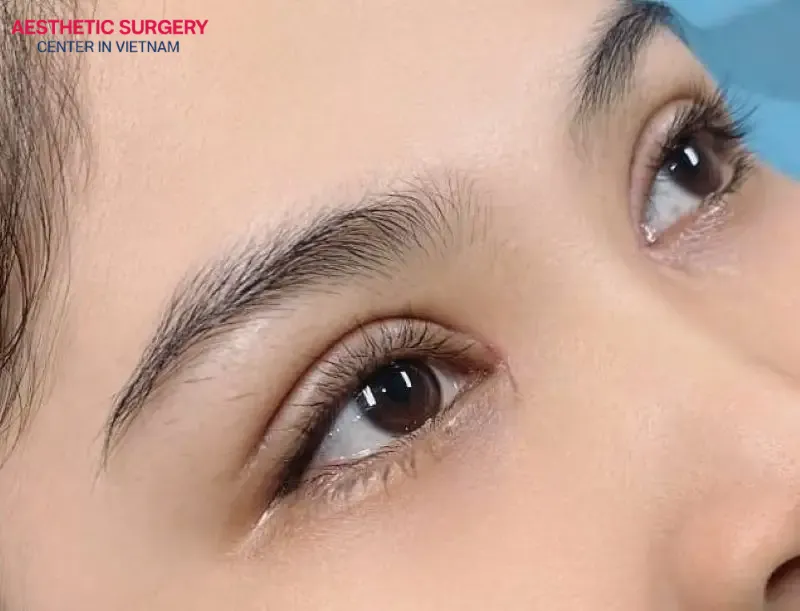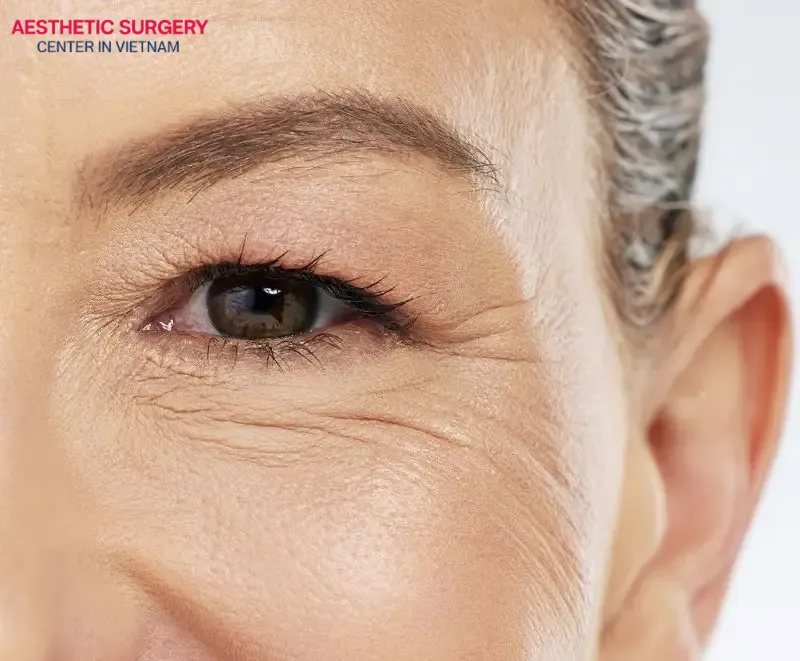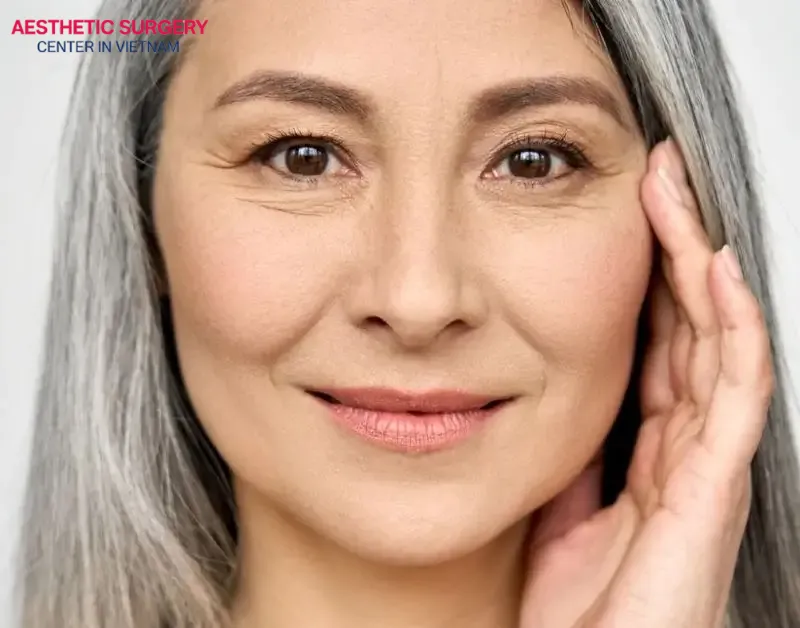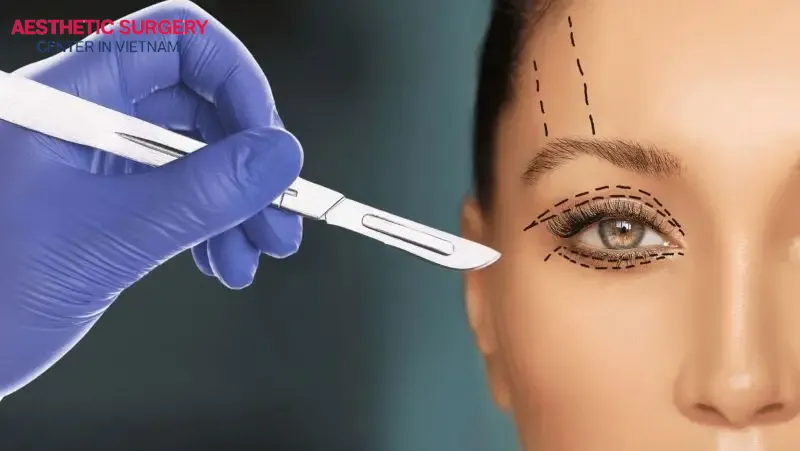A brow lift is a cosmetic procedure designed to enhance the forehead and eye area where signs of aging are often most visible. When the eyebrows droop or the eyelids begin to sag, the face may appear tired or lacking vitality. The article below will help you understand what a brow lift is, explore the available procedures, and determine who it is best suited for to help you achieve a fresher, more youthful appearance.
Overview of brow lift
What is a brow lift? A brow lift is a modern cosmetic procedure that corrects drooping or sagging eyebrows. As we age, the skin on the forehead and around the eyes gradually loses its natural elasticity, causing the brows to descend, the eyelids to droop, and the face to appear tired and older than it really is. This is one of the most noticeable signs of aging in both men and women.
A brow lift helps reposition the eyebrows to a higher, more youthful location, improves the appearance of droopy eyelids, and brings a refreshed, more vibrant look to the face. Beyond its aesthetic benefits, in some cases, this procedure can also enhance vision by lifting excess skin that obstructs the eyes.
This cosmetic procedure is also known by other terms, such as:
- Forehead lift
- Forehead rejuvenation
- Temporal brow lift

What is a brow lift?
A brow lift is a modern cosmetic procedure designed to reposition sagging eyebrows while also smoothing wrinkles on the forehead and around the outer eyes. The procedure involves adjusting the underlying muscles or skin in the forehead area to lift the drooping brows. Depending on individual needs and the level of skin aging, a brow lift can be performed through surgical methods (such as endoscopic or skin excision procedures) or non-surgical approaches (like Botox injections or thread lifting).
Beyond its aesthetic benefits, a brow lift may also help improve vision in cases where severely drooping eyelids obstruct sight. Overall, this procedure helps restore a more youthful and refreshed appearance to the face.
What does a brow lift do?
A brow lift is more than just a simple cosmetic procedure, but can significantly enhance your overall appearance. Below are some of the common improvements seen after undergoing a brow lift:
- Reduces forehead and brow wrinkles.
- Creates a more balanced and harmonious eyebrow shape, correcting drooping brows that may make the face appear tired.
- Improves vision without operating directly on the eyelids.
- Even with just a few subtle adjustments to the forehead and brow area, the face appears brighter, more alert, and noticeably sharper.
Who is a candidate for a brow lift?
Here are some groups of people who may be ideal candidates for a brow lift. You can use this as a reference to see if the procedure suits your needs:
- Individuals aged 30 and above who are starting to notice forehead wrinkles or signs of aging around the eyes.
- People with low-set eyebrows or drooping outer brows make the face look tired or less vibrant.
- Those who want to improve their appearance without undergoing major surgery.
- Individuals who have had Botox but are no longer seeing significant results and want a longer-lasting solution.
- People whose eyelids appear partially covered due to sagging brows.

What are the types of brow lift procedures?
Depending on the degree of brow sagging and individual aesthetic goals, doctors may recommend different brow lift procedures. Below are the most common brow lift procedures widely used today:
Endoscopic brow lift
Endoscopic brow lift is a minimally invasive procedure in which the doctor makes small incisions near the hairline. Then, an endoscope and specialized instruments are inserted to lift and fix the underlying tissues, repositioning the brow to a higher position. Brow lift using an endoscopic tool leaves minimal scarring, and the scar is hidden within the hair.
Direct brow lift
A direct brow lift involves surgically removing a portion of skin just above the brow line or along the brow itself. The surgeon will eliminate excess skin or lax muscle tissue that contributes to drooping eyelids, then suture the brow into a lifted position. This procedure is particularly suitable for individuals with significant skin redundancy in the brow area or those seeking more immediate and noticeable results.
Temporal brow lift
The temporal brow lift focuses on elevating the outer tail of the eyebrows. This procedure involves making a small incision in the temple area, usually hidden within the hairline. The surgeon then lifts and secures the underlying tissue to raise the outer brow.
A temporal brow lift is ideal for those who only need a subtle lift at the brow tail or want to reduce tiredness around the outer eye area without needing full forehead intervention.

Is there a nonsurgical brow lift?
If you’re looking to lift your brows without undergoing surgery, there are several non-invasive procedures currently available:
Botox injections for the brow area
Botox works by relaxing the muscles that pull the brows downward, mainly those in the forehead and around the eyes, creating a subtle lifting effect, giving the face a more alert and youthful appearance without sacrificing natural expressions. This procedure is ideal for individuals with mild brow drooping or early signs of forehead wrinkles. Results typically last 3–6 months, after which follow-up treatments may be considered.
Thread lifting (Biological threads)
This procedure involves inserting absorbable threads, such as collagen or PDO threads, under the skin to physically lift sagging brow tissue. The results are often noticeable immediately after the procedure and can last 12–24 months, depending on the type of thread and individual skin condition. Thread lifting is generally suitable for those experiencing mild to moderate brow ptosis who want improvement without undergoing surgery.
RF and HIFU technology
RF (Radio Frequency) and HIFU (High-Intensity Focused Ultrasound) are non-invasive rejuvenation procedures that use thermal energy to stimulate collagen production and tighten the skin around the forehead and eyes. As a result, the brows are gently lifted in a natural way, and the skin appears firmer and smoother. These procedures are ideal for individuals with mild skin laxity who do not have time for skincare.

Eyebrow lift procedure details
Following a medically standardized procedure is key to ensuring safety and achieving the desired aesthetic outcome. Below are the basic steps typically involved in a brow lift procedure:
What happens before a brow lift procedure?
Some important preparations you need to make involve medical and personal information before undergoing a brow lift. This helps the doctor properly assess your condition, ensure you’re eligible for the procedure, and that it proceeds safely, such as:
- Schedule a consultation to have your skin evaluated by a qualified doctor.
- Complete any necessary health screenings if you’re undergoing a surgical brow lift.
- Inform your doctor about any medications or supplements you’re currently taking (especially blood thinners).
- Avoid makeup and cleanse your face thoroughly on the day of the procedure.
What questions should I ask my provider before my brow lift procedure?
To help you better understand the procedure and clarify any questions you may have about what a brow lift is, don’t hesitate to ask your doctor the following during your consultation:
- How long will it take for the brow area to stop swelling and return to normal?
- Which brow lift procedure is most suitable for my condition?
- How long will the results last, and will I need any follow-up injections or additional treatments?
- If there is a scar, will it be well hidden?
- How should I care for the scar so it heals quickly and fades?
- What is the total cost for the entire treatment?
What should I do to prepare for a brow lift procedure?
To ensure your brow lift goes smoothly and safely, it’s important to prepare both physically and mentally. Here are some essential steps you should take beforehand:
- Stop using any medications that affect blood clotting 1–2 weeks prior, as advised by your doctor.
- Avoid smoking and alcohol for at least 1 week before the procedure to reduce the risk of inflammation and prolong the healing process.
- Maintain a balanced and healthy diet. You can drink plenty of water and have a light meal the evening before or the morning of the procedure if permitted by your doctor.
- Wash your face thoroughly, and avoid wearing makeup or applying skincare products on the day of your brow lift.
- If your procedure involves anesthesia, arrange for a family member or friend to accompany you, take you home, and assist with post-op care.

Is a brow lift an inpatient or outpatient procedure?
Most brow lift procedures today are minimally invasive and are typically performed on an outpatient basis. This means you can return home the same day after the treatment is completed. You’ll only need to carefully follow the post-care instructions provided by your doctor to ensure a smooth recovery and achieve the desired results.
What happens during a brow lift procedure?
The brow lift procedure typically follows a few essential steps, depending on the type of procedure selected. For surgical brow lift procedures, below are the basic steps:
Step 1: Anesthesia or sedation
Before the procedure begins, you’ll be given local anesthesia to ensure you feel no pain during the operation. In some cases, if you’re feeling anxious or prefer complete relaxation, your doctor may offer light sedation.
Step 2: Making the incisions
After the anesthesia takes effect, the surgeon will carefully create small incisions at predetermined locations. These incision points depend on the brow lift procedure you’ve chosen, such as within the hairline, just above the brow, or in the temple area. These incisions allow the surgeon to access the underlying muscle and soft tissue structures beneath the skin.
Step 3: Adjusting soft tissue and muscles
This is a critical step in the brow lift. Through the incisions, the surgeon will skillfully reposition or tighten the sagging muscles and connective tissues beneath the skin. This adjustment helps elevate the brow to a higher, more youthful position while also smoothing forehead lines and rejuvenating the eye area.
Step 4: Removal of excess skin if necessary
In cases where there is significant sagging skin, the surgeon may remove a small amount of excess tissue. This step helps ensure the brow lift achieves a more noticeable, natural, and harmonious result with your facial features.
Step 5: Closing the incisions
Once all adjustments are completed, the incisions will be carefully closed using cosmetic sutures, medical adhesive, or surgical staples, depending on your procedure. The area will then be gently bandaged to protect the wound and prevent exposure to harmful external factors.
Step 6: Post-procedure monitoring and care instructions
You will be taken to a recovery area for a short rest period to stabilize. During this time, your doctor or medical staff will give you detailed post-care instructions, including how to keep the area clean, how to take pain relief medications at home, and specific precautions to follow. In most cases, if the brow lift is performed as a standalone procedure without combining it with other procedures, you can return home the same day.

Is a brow lift painful?
The brow lift procedure is often much less intimidating than most people imagine. Throughout the treatment, you’ll be under local anesthesia or mild sedation, so you won’t feel any pain during the procedure.
After the procedure, it’s normal to experience some tightness, mild swelling, or bruising around the forehead area, especially in the first few days. These sensations typically subside within 7–10 days. If you’re opting for non-surgical methods like Botox injections or thread lifting, the discomfort is usually limited to a slight pricking sensation, no long-lasting pain.
However, if you experience intense, persistent pain, redness, warmth, or pus at the incision site, contact your doctor immediately, as these could be signs of complications such as infection, fluid buildup, or inflammation.

What happens after a brow lift procedure?
After undergoing a brow lift, it’s best to rest for the first 1–2 days and avoid intense physical activity or any direct pressure on the forehead area. Common post-procedure symptoms include:
- Mild swelling, bruising, or a feeling of tightness
- Temporary numbness around the forehead, which may last from a few days to a few weeks
- If you’ve had a surgical brow lift, you may need to return for suture removal after about 5–7 days, and follow-up visits as directed by your doctor
Pros and cons of eyebrow lift
A brow lift is an effective aesthetic solution that offers significant rejuvenation benefits. However, like any cosmetic procedure, it comes with both advantages and potential risks. Understanding both sides will help you make a well-informed decision:
What are the advantages of a brow lift procedure?
A brow lift is not only a cosmetic enhancement but also brings a range of practical advantages:
- Rejuvenates the entire forehead, eyes, and brow area, helping your face appear noticeably younger, brighter, and more vibrant.
- Improves vision in cases where sagging skin or drooping brows partially cover the upper eyelids.
- Long-lasting results, with effects that can last anywhere from 3 to 10 years, depending on the chosen procedure.
- Various options available, including non-surgical and minimally invasive methods, tailored to different needs and degrees of brow drooping.
What are the risks or complications of a brow lift procedure?
- Hematoma or infection is a general risk associated with any invasive procedure. However, this is very rare when the procedure is performed under sterile conditions and you follow proper aftercare instructions.
- Temporary numbness or loss of sensation in the forehead may occur after injections or surgery, but this usually resolves over time.
- Asymmetry or uneven brows can result if the doctor’s technique is poor or if the dosage is unevenly distributed.
- Visible scarring may happen in surgical procedures with clear incisions, especially if wound healing is poor, potentially affecting aesthetics.

FAQ
When exploring what a brow lift is, many people still wonder about its effectiveness, recovery time, and more. Below are the frequently asked questions related to brow lift procedures:
When will I see the results of a brow lift?
You may begin to notice improvements a few days after the procedure, especially as swelling and minor bruising around the forehead and brow area start to subside. However, for the brow position to fully stabilize, the forehead skin to appear smoother, and your overall expression to look more refreshed, it typically takes 2 to 3 months for full recovery. To achieve the best results, it’s important to strictly follow your doctor’s aftercare instructions, attend all follow-up appointments, and avoid intense physical activities.
How long does a brow lift last?
For surgical brow lift procedures, the results typically last 5 to 10 years, or even longer if proper aftercare is followed during the healing process. In contrast, non-surgical procedures such as Botox injections or thread lifts usually provide results that last around 6 months to 2 years, depending on your skin condition and the doctor’s technique.
It’s important to note that while aging continues over time, wrinkles and brow sagging tend to return more gradually and less noticeably compared to before treatment.
Can I get multiple cosmetic procedures done at the same time as a brow lift?
Common procedures often performed alongside a brow lift include:
- Eyelid surgery
- Facelift
- Neck lift
- Skin rejuvenation with technology
- Dermal fillers or Botox in other facial areas
Combining cosmetic procedures can save both costs and recovery time. However, it’s important that you undergo a thorough consultation and examination with your doctor to assess your health and suitability before the procedure, ensuring safety and effectiveness.

Hopefully, this article has helped you better understand what a brow lift is. A brow lift not only brings a more youthful appearance but can also significantly improve your vision and boost your confidence in daily life. Whether you choose a surgical or non-surgical procedure, the most important thing is to understand your own condition and consult with a qualified specialist for proper guidance.







Comment on the post